
Yellowstone works to protect wildlife
In what is one of the most recognizable national parks in the United States, the population of a few species of wildlife is being closely monitored.
Yellowstone National Park is widely known for having a rich variety of wildlife. However, several prominent species face threats to their respective populations, specifically gray wolves, pronghorn antelope and grizzly bears.
“A threatened species is any species which is likely to become an endangered species within the foreseeable future throughout all or a significant portion of its range,” said Kerry Gunther, Bear Management biologist at Yellowstone National Park. “An endangered species is any species which is in danger of extinction throughout all or a significant portion of its range.”
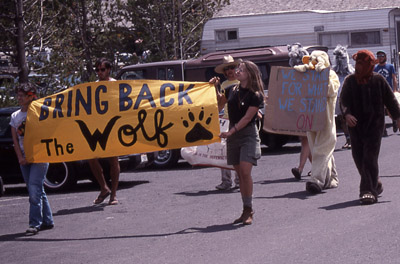 |
At left, demonstrations occurred to support reintroducing wolves. Next below, wolves arrive at Yellowstone National Park. Next, a small group of pronghorn roam. Next, wolves and bears peacefully coexist. Last, a grizzly bear (Photos courtesy of National Park Service). |
While gray wolves and grizzly bears are federally designated as threatened and endangered species, respectively, pronghorn antelope are not designated as either. The number of pronghorn in Yellowstone National Park, however, appears to be dwindling.
Gray Wolves
Wolves were reintroduced to Yellowstone National Park in 1995-96. The park brought in 14 of them in the first year of reintroduction and then 17 followed the year after.
“The plan involved going to Canada to capture new wolves to release every year and we were going to do that for three to five years,” said Doug Smith, project leader for the Yellowstone Gray Wolf Restoration Project. “We thought there’d be much more mortality, that 80 percent would be killed the first year. But the wolves adapted so well and 80 percent survived.”
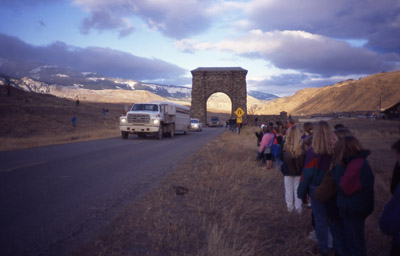 Since 1995, Yellowstone’s wolf population has mostly stabilized, although there have been several ups and downs in numbers due to disease.
Since 1995, Yellowstone’s wolf population has mostly stabilized, although there have been several ups and downs in numbers due to disease.
“Our wolves were masters at life in the wild,” said Smith. “Yellowstone provides a great core habitat [as] we don’t have poaching in the park.”
However, recently the population of wolves in Yellowstone National Park has declined. According to statistics issued by Yellowstone National Park in January 2009, the 2008 population was at 124 wolves, which is a 27 percent decrease from the 171 wolves in 2007.
The decrease in wolf population was most noticeable on the northern range, where the wolf population is down 40 percent from 94 to 56 wolves. Park officials also point out that the most likely causes for the recent population decline are distemper, mange and wolves killing each other.
Wolves were delisted from the federal endangered species list in March 2008, but relisted again in July 2008.
Pronghorn Antelope
Pronghorn antelope are neither a threatened species nor an endangered species and the population of pronghorn in the western United States is not in danger. However, Yellowstone’s pronghorn herd is at historically low numbers.
The reason for the population scarcity is human development that north of Yellowstone that is affecting the pronghorn’s migration routes.
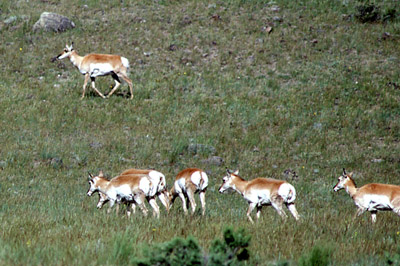 “North of the park, there is an area called Paradise Valley, which is an area of land that would be ideal for pronghorn to migrate to,” said Troy Davis, biological technician at Yellowstone National Park. “However, between there and the park lies an area of development, and we do think that is enough to prevent the pronghorn from moving to Paradise Valley.”
“North of the park, there is an area called Paradise Valley, which is an area of land that would be ideal for pronghorn to migrate to,” said Troy Davis, biological technician at Yellowstone National Park. “However, between there and the park lies an area of development, and we do think that is enough to prevent the pronghorn from moving to Paradise Valley.”
Pronghorn are a migratory species by nature, and fences, agricultural fields and an increase in housing subdivisions beyond park boundaries to the north all have had an influence on their potential migration routes
“They are particularly susceptible to fencing, and for whatever reason they won’t jump over fences – they try to crawl under,” said Davis.
What was once a migration route of 70 miles has been reduced to now only 30 miles. Pronghorn are accustomed to running long distances and Yellowstone is increasingly becoming an island for them.
According to P.J. White, chief of Aquatic and Wildlife Resources for Yellowstone National Park, the most common predators of female pronghorn in Yellowstone are coyotes, cougars and wolves. More than half of the adult pronghorn deaths from predation between 1999 and 2006 were caused by coyotes.
The pronghorn are still occasionally preyed on, despite the fact that their speed is second only to that of cheetahs. The loss of their migration routes has most likely contributed to an increase in threats from predators.
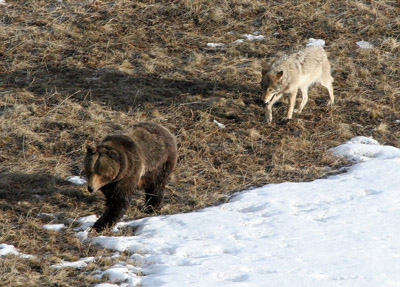 While the introduction of wolves to Yellowstone in 1995 has resulted in the deaths of some pronghorn, the pronghorn only make up only about one percent of a wolf’s diet.
While the introduction of wolves to Yellowstone in 1995 has resulted in the deaths of some pronghorn, the pronghorn only make up only about one percent of a wolf’s diet.
“There is a theory that wolves benefit pronghorn,” said Davis. “Wherever you have wolves, you have fewer coyotes, so you also see less predation from coyotes on pronghorn. The wolves very rarely take an interest on pronghorn.”
According to Davis, there is no trajectory of threat to Yellowstone’s pronghorn population. However, because the population of Yellowstone’s pronghorn herd is so small, it is very susceptible to sudden dangers. Outbreaks of disease, extreme weather, or even small changes to their migration routes would all be enough to severely impact the pronghorn.
Grizzly Bears
The grizzly bear was federally designated as a threatened species in 1975, which means that recovery of the species to a self-sustaining population is required.
In 1992, The Grizzly Bear Recovery Plan was implemented. The program was updated again in 2006.
“Every year the grizzly bear cub production in the park is significantly greater than the number of human-caused mortalities in the park,” said Gunther.
The grizzly bear does not have many natural predators in Yellowstone National Park. However, according to Gunther, grizzly bears occasionally face threats from wolves.
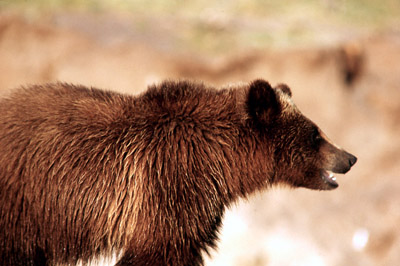 In an article written by Smith and Gunther, the two Yellowstone researchers describe how most interactions between wolves and grizzly bears (particularly females) are neutral encounters.
In an article written by Smith and Gunther, the two Yellowstone researchers describe how most interactions between wolves and grizzly bears (particularly females) are neutral encounters.
On a rare occurrence, grizzly bears, most often cubs, are killed by wolves. The primary diet for Yellowstone gray wolves, however, consists of elk and other similar animals.
The main issue surrounding grizzly bears in Yellowstone relates to their interactions with humans.
“There are very few threats to grizzly bears inside Yellowstone National Park,” said Gunther. “We have almost no human-caused mortality within the park. A grizzly bear gets hit and killed by a vehicle almost once every two years and a grizzly bear involved in conflicts with humans is captured and removed (euthanized or sent to a zoo) about once every three to five weeks.”
Although the grizzly bear was taken off of the federal threatened species list in 2007, a federal judge in Montana just recently ruled to reinstate the grizzly as a threatened species on Sept. 21.
“If and when they get de-listed from threatened species status is a political process,” said Gunther. “The grizzly bear is an omnivore generalist capable of adapting to most environmental changes. It is usually human factors and values that determine where bears can and cannot persist.”

Comments are Closed